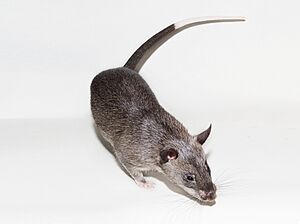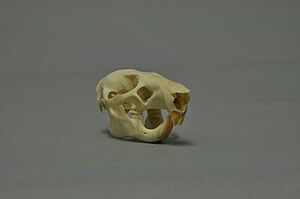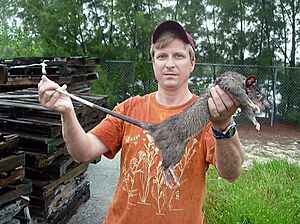Gambian pouched rat facts for kids
Quick facts for kids Gambian pouched rat |
|
|---|---|
 |
|
| A captive pet | |
| Conservation status | |
| Scientific classification | |
| Genus: |
Cricetomys
|
| Species: |
gambianus
|
The Gambian pouched rat (Cricetomys gambianus) is also known as the African giant pouched rat. It is a type of pouched rat that is active at night. These rats belong to the giant pouched rat group Cricetomys.
They are some of the biggest rodents in the world. They can grow to about 0.9 m (3 ft) long, including their tail. The tail makes up half of their total length! You can find them across sub-Saharan Africa, from Senegal to Kenya. They live from sea level up to 2,000 m (6,600 ft) high.
Sometimes, people keep Gambian pouched rats as pets. However, some have escaped and become an invasive species in Florida. In the United States, it is now against the rules to bring these rats into the country. This is because they were linked to a monkeypox outbreak in 2003.
Contents
What are Gambian Pouched Rats Like?
Gambian pouched rats have very poor eyesight. So, they rely on their strong senses of smell and hearing. Their name comes from the large, hamster-like pouches inside their cheeks. These animals are not true rats. They are part of a different group of muroid rodents from Africa.
These rats usually weigh between 1.0 and 1.4 kg (2.2 and 3.1 lb). In Africa, they live in groups of up to 20. They often make their homes in forests and thick bushes. You can also find them living in termite mounds. They are omnivores, meaning they eat both plants and animals. Their diet includes vegetables, insects, crabs, and snails. But they seem to especially love palm fruits and palm kernels.
Their cheek pouches are very useful. They can gather several kilograms of nuts in them each night. They then store these nuts underground. Sometimes, they stuff their pouches so full that it's hard for them to squeeze into their burrows! Their burrows are long tunnels with side paths and several rooms. One room is for sleeping, and others are for storing food.
Gambian pouched rats can start having babies when they are 5 to 7 months old. They can have up to four groups of babies every nine months. Each group can have up to six young rats. Male rats can be aggressive when they meet other males.
HeroRATS: Sniffing Out Danger
A group called APOPO trains a type of giant pouched rat. These rats are very similar to the Gambian pouched rat. They are taught to find land mines and tuberculosis using their amazing sense of smell. These trained rats are called HeroRATS.
Training a rat is much cheaper than training a dog to find mines. It costs about $7,300 to train a rat for nine months. A dog's training costs about $25,000. However, dogs usually live twice as long as rats.
In 2020, a Hero Rat named Magawa received a special award. It was the People's Dispensary for Sick Animals Gold Medal. This is like a very high honor for animals. Magawa was the first rat to ever get this award. Before he retired in 2021, Magawa found 71 landmines. He also found 38 pieces of unexploded bombs. He helped clear over 2,421,880 sq ft (225,000 m2) of land in Cambodia. This saved many people from getting hurt or killed. Magawa died peacefully at 8 years old in 2022.
Detecting Tuberculosis
Similar giant pouched rats are also used to help find tuberculosis (TB). Scientists at Cornell University are studying how useful these rats are. They can sniff out TB in human spit samples. These rats are also used in Mozambique and Tanzania to help check for TB.
When Rats Become a Problem
Gambian pouched rats have become an invasive species in Florida. This happened after some escaped from a private breeder in the 1990s. Since 2007, wildlife experts in Florida have tried to get rid of them. But they were still present in 2014. They have also been seen in nearby areas like Key Largo.
These large African rodents are also thought to be the cause of the 2003 Midwest monkeypox outbreak in the United States. They spread the disease to prairie dogs that people bought as pets. In 2003, the government stopped people from bringing these rodents into the country. This happened after the first monkeypox outbreak was reported. About 20 people were affected by the disease.




